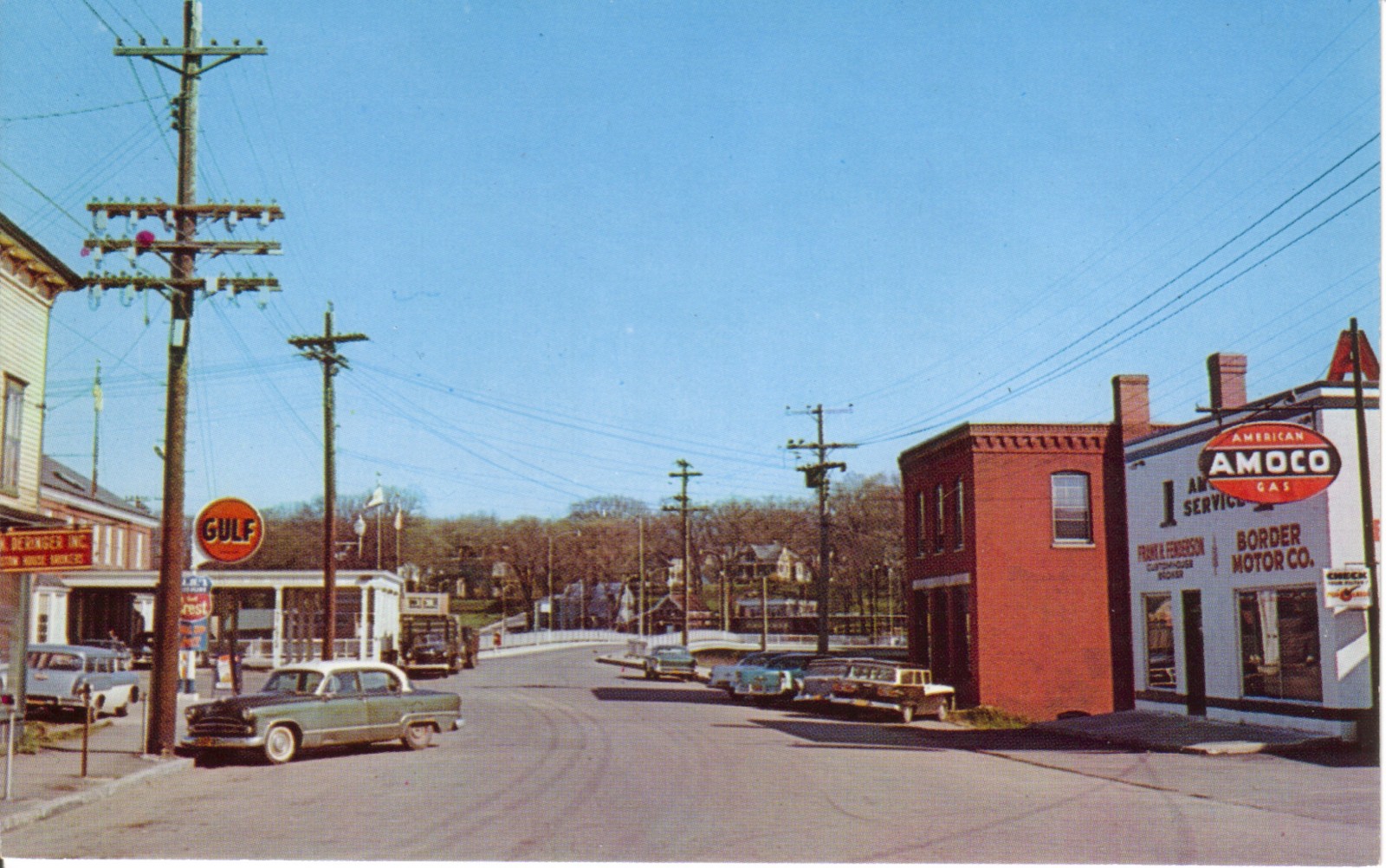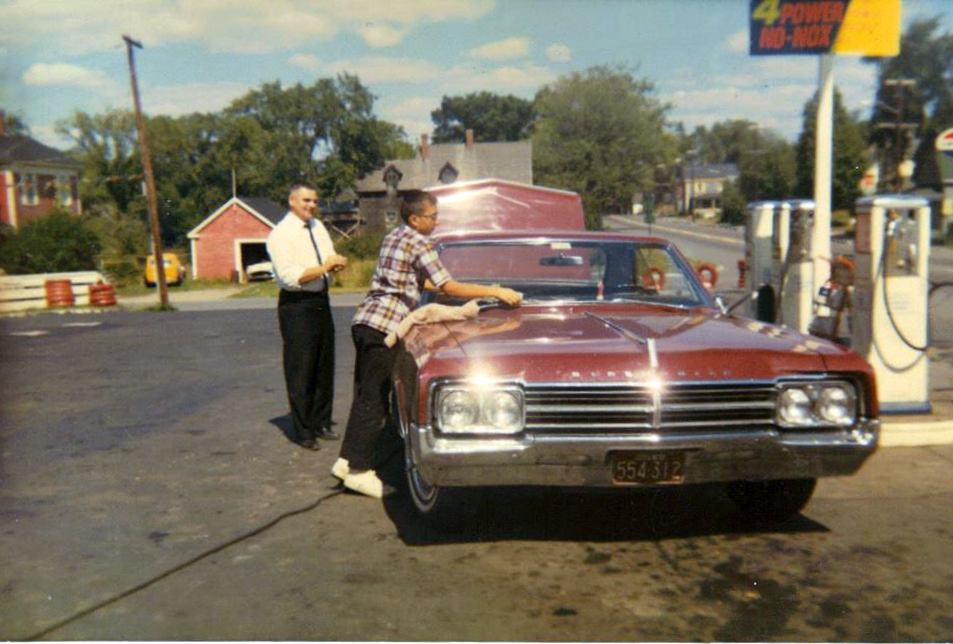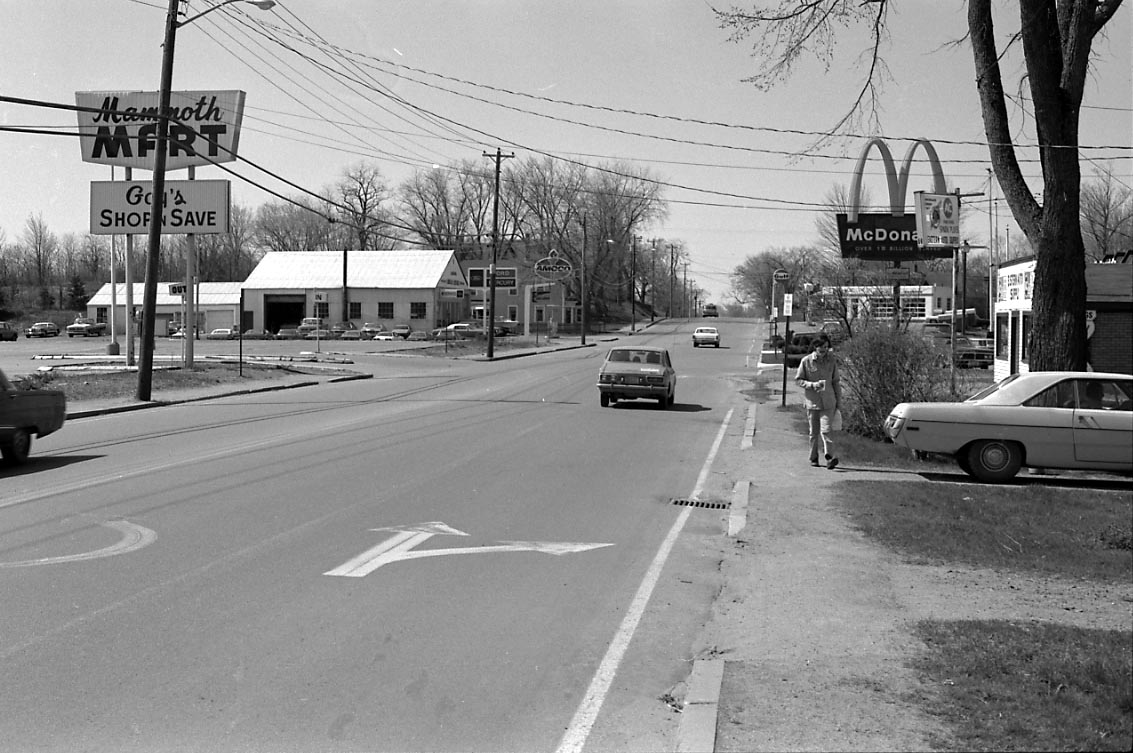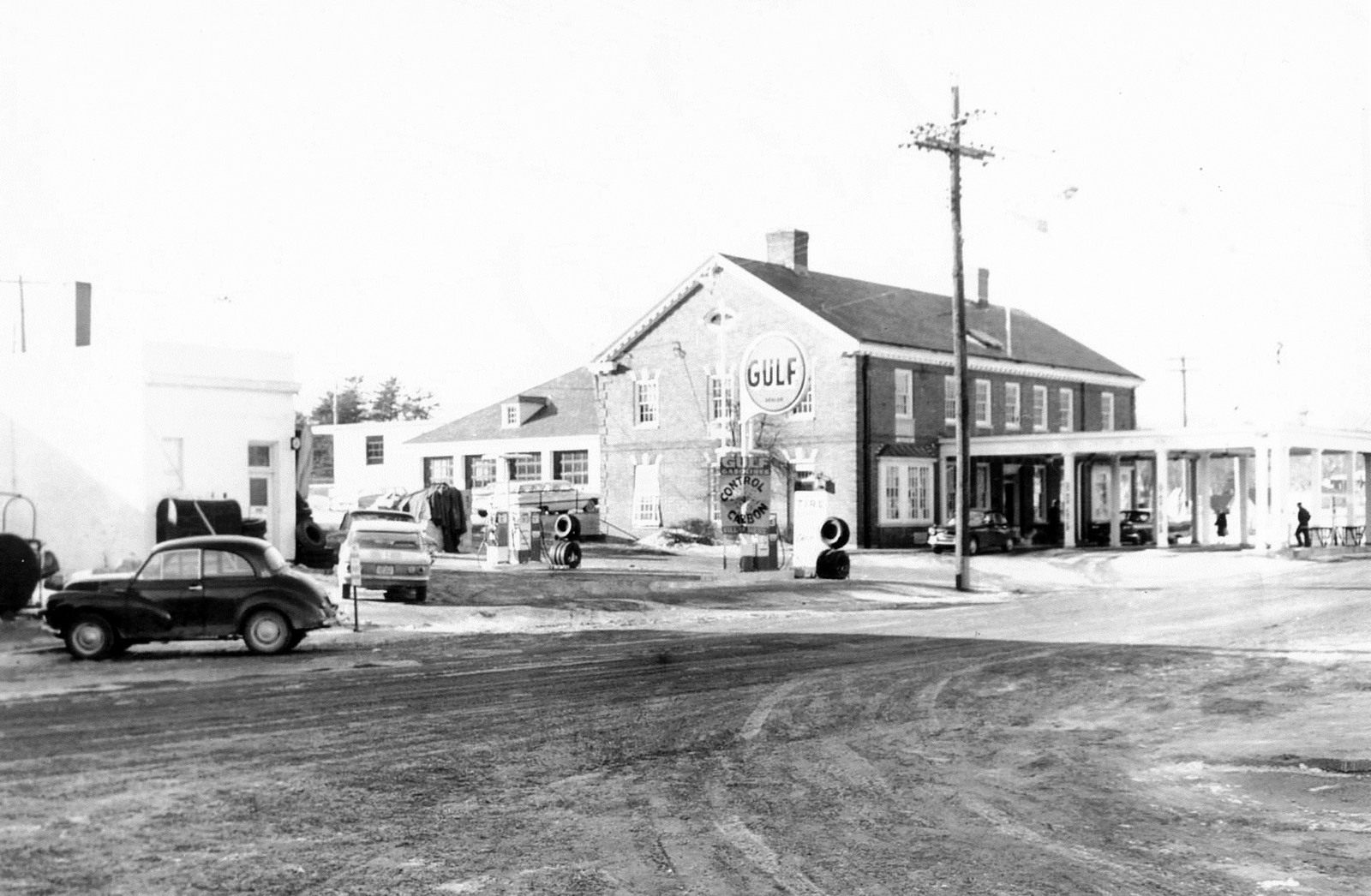
As the price of gas heads up we thought it timely to do a piece about gas stations of the past. Back in 1959 when gas cost 29 cents a gallon and sometimes less when one of local “gas wars” was raging, Calais had a lot of gas stations. The photo above is Barnes Cities Service at the corner of Main Street and Hog Alley. The St Croix Hotel and a competing Mobil station are in the background.

In the other direction along Main Street toward Calais Avenue were Cole Bridges and, pictured above, garage row, a half dozen garages and filling stations. John Mitchell once recited from memory the names and locations of about 25 local gas stations of that era and admitted he was sure he’d missed a some. Today we have a couple of Irvings, On the Run and Valero and Hardwick’s by the bridge. There are none left in Milltown. Of course in the 50’s cars were not very reliable, always needing tune ups, the occasional engine job and, depending on how you drove, a new transmission and clutch or two. Kids knew how to change a flat before they were out of diapers. Car owners wanted a mechanic they trusted and many gas stations had a mechanic on duty who was often the owner. Everyone claimed to patronized the “best garage” in town with the “best mechanic”. Heated arguments would sometimes ensue and it was embarrassing to have your car backfire and break down on Main Street on a Saturday afternoon.

We offer no opinion on the “best garage” issue but can tell you which gas station had the best location in Calais-the Gulf Station on River Street at the corner of Main by the bridge. It offered a “Last Chance” to buy cheaper U.S. gas before venturing into foreign lands where gas prices were historically much higher. This, however, wasn’t really much of an advantage as the tourist had already passed a dozen gas stations on his way through town. The great advantage enjoyed by this Gulf station was capturing the returning tourist when he was a mere 20 feet back into the country. The exit lanes from Customs lined up nearly perfectly with the station’s gas pumps. In fact a sharp left and then a right were required for the returning tourist to avoid the gas pumps and why bother as the frugal driver had been nursing his car from St John on empty to reach the land of cheap gas.

The cars above, all on empty, are hoping it won’t take too long to clear customs. The car to the far left appears to be heading for the pumps at the Gulf Station. If you look carefully at the three men standing on the outside lane you may recognize a familiar Calais figure- Luther Barnes, Chief of Police.

This photo shows the station in the late 50’s. It may have been owned then by Les Dunn. A gas station at this location first appears on Calais maps in 1925, in the late 1800’s the corner was occupied by a store owned by the Murchies whose main lumber wharf was just across the street in back of what is now Harwick’s. We do not know when Dunn bought the station but the location certainly became more valuable in 1935 when the new Customs building opened and essentially funneled hundreds of cars a day to its gas pumps. Before 1935 Customs was on the other side of Main Street. Dunn was born in Dennysville and probably moved to Calais after serving in the Army in World War 2. He sold the station to Albert Ayer, also born in Dennysville and Navy veteran, about 1960. Albert had married a local girl, Bonnie Rutherford and he had a reputation for deviltry. Carole Allen, whose father was the Gulf distributor in the area in the 40’s and 50’s remembers both Les Dunn and Albert Ayer:
I remember being at Les Dunn’s his home and meeting his first wife when I was just a kid…I think they lived in the Red Beach area at that time…probably we were there to deliver the Japanese flag and sword plus the photo of the naked Japanese girl he had sent my father to keep until he returned from the war. I know I mentioned that to you awhile ago……He was a charmer. I do think he had a son but not sure about that. I think Albert was part of the Ayers’ family from Pembroke….the father had a Gulf garage there and I think he had two sons…one son named Robert who seemed like a very nice man and there was Albert….but I was only a kid when I met that family so my memory could have slipped an ‘Ayer’ [heir] or two….
Dennis Mahar confirms Albert had grown up in Pembroke:
Albert grew up in West Pembroke, where his father, Lloyd, had a service station on Willow Brook, where my aunt, Norma Cushing, when borrowing her brother Herb Clark’s car on the condition that she put gas in it, would buy 25 cents worth. My father has many stories of growing up with Albert. I suspect they kept Judge Blackwood on his toes at Pembroke High School.
The suggestion that Albert was a bit of a character are confirmed by a local customs officer who worked for many years at Calais Customs:
Albert did his patriotic duty helping U.S. Customs by breaking down tires suspected of hiding “contraband” including of course marijuana. Since the street separating the two was narrow, he would often yell to the inspectors doing secondary examinations in front of the Customs garage “it’s in the spare tire” especially in the afternoon after a “few.” In addition to providing him with a bit of a chuckle, it also generated some spare income with which to keep his legendary fridge continually supplied with fresh “toddies.” Albert Ayer was quite a character. When weather permitted, he and Paul Archer would sit outside in lawn chairs in front of the garage and torment passersby, customs/immigration officers, and anyone going into Hardwicks that would pay attention to them. One fine day a frequent customer obviously out of favor stopped in for gas and a chat. While Paul entertained him, Albert filled his tank and spread a light coating of engine oil on his wipers so the next rain storm this fellow would get a big smear instead of a clean windshield. Most of the pranks, however, were harmless with louder voices the norm as the day wore on.

After Les Dunn, above, sold the station at the bridge to Albert Ayers he opened another Gulf station on North Street where Rite-Aid is now located.

This photo is from 1965, well before the Mammoth Mart and McDonald’s opened. The area was not yet the commercial center it became in the 1970’s but by then we believe Dunn had sold out to Cliff Pollock.

This photo is 1969. The fellow cleaning the windshield sent us the photo but we’re drawing a blank on his name. Chandler Street is in the background as are the houses on North Street which were moved or torn down to build McDonald’s. Across the street is Gibson’s garage, now Machias Savings Bank but in 1969 it was a still mostly residential. McDonald’s and Mammoth Mart were a couple of years in the future.

Why Dunn abandoned his great location by the bridge to move to North Street is a mystery unless he foresaw the North Street area would become the commercial center of the town. This early 1970’s photo shows Johnson’s Plumbing, McDonald’s and the Gulf station on the right, Mammoth Mart, Gay’s grocery store and Gibson Motors on the left. The area changed dramatically in the course of just a couple of years and little did we realize it was the beginning of tough times for Main Street.

We added this photo because the Gulf garage near the bridge is in the background and some of the marchers may be familiar to many of you. A hint- Joe Hinton, Francis Brown, Bill Tracy Calais Police Officer and Frank Beckett. Also, of course, the photo shows the corner of Andrews Store and the hot dog stand.

Lastly this photo is included for car buffs as it shows two classic vehicles at Ayer’s garage, the Morris Minor to the far left and the Corvair to the right of the Morris Minor. The Morris Minor, originally named the Morris Mosquito, was a British product with a very distinct profile and very little power. The 1952 model had a top speed of 62 MPH and went from 0-50 in a mere 28.6 seconds. However it got 39.3 miles per gallon which meant you could drive to Princeton and back for 29 cents. The Corvair gained notoriety both as the only U.S. car produced with the engine in the rear and for earning the reputation as being “Unsafe at any speed”.
